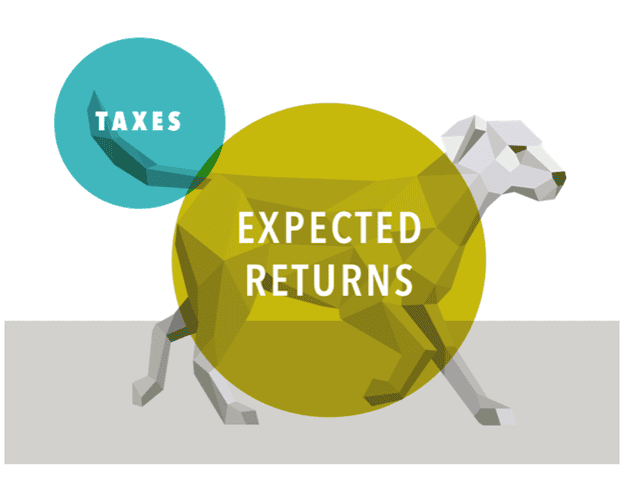Please provide your information and submit this form. Our team will be in touch with you shortly.

There is one surefire method that will allow you to legally pay zero taxes: make zero income. Of course, that alternative is not very palatable to many of us, so most investors are interested in ways to at least minimize the taxes due on their investment gains. But sometimes, it can be tempting to let the “tax-efficiency” tail wag the “total returns” dog. Remember, the object of investing is to position yourself for long-term gains that will permit you to achieve your most important goals. This is why investors who pursue increases in assets characterized by expected gains in value, size, profitability, and other parameters will often be positioned for greater wealth creation over time and, thus, a higher tax bill.

Image courtesy Dimensional Fund Advisors
Perhaps a better way of thinking about the profitability/tax paradigm is to concentrate on after-tax wealth. Rather than placing the primary focus on tax minimization, it may be better to emphasize maximizing after-tax wealth. Fortunately, there are a number of ways investors can pursue tax-efficiency while still positioning themselves for significant portfolio gains over time. Let’s take a look at a few.
We’ve written previously on the value of tax planning for enhancing portfolio value. For high earners (those in the 32–37% marginal tax brackets for 2025), there are measures that can be taken that give some control over your tax bill without constraining your ability to seek higher long-term growth for your investments. Many of these involve making smart use of various deductions: tax-favored accounts, bundled charitable deductions, business structures, and others. Several of these involve changing the character of your income for more favorable tax treatment.
This may seem obvious, but it bears repeating: funneling income into tax-favored retirement accounts can be a fundamental building block of not only your retirement funding strategy, but also your ability to exercise some control over your tax bill. Depending on your eligibility, if you have access to an employer-sponsored plan like a 401(k) or 403(b), contributing to your traditional plan lowers your tax bill, dollar for dollar, by the amount of your contribution. In 2025, you can contribute up to $23,500 to your plan, and if you are 50 or older, you can contribute an additional $7,500 as a catch-up contribution. Additionally, the funds in the plan can be invested for long-term growth that is not subject to taxation as long as they remain within the plan. So, you can get a reduction in your taxable income now, plus the ability for long-term accumulation that is not hampered by taxation, year to year.
For some high earners, it may make sense to invest a portion of the portfolio in tax-exempt bonds (municipal bonds). Interest earned on such bonds is exempt from federal income tax, and for those living in states with no state income tax (like Texas, Alaska, Florida, Nevada, New Hampshire, South Dakota, Tennessee, Washington, and Wyoming), that means that the income from tax-exempt bonds is generally tax-free. While such earnings do increase your modified adjusted gross income (MAGI), which can in turn affect your eligibility for certain tax credits and other considerations, generating tax-exempt income can help many high earners reduce their year-to-year federal income tax burden.
A Health Savings Account (HSA) can be used by some high earners to pay for qualified medical expenses on a tax-advantaged basis. To use an HSA, you must first have a high-deductible health plan (HDHP), and the contribution limit for families is $8,550 in 2025. If you are 55 or older, you can also make a catchup contribution of $1,000. Contributions to an HSA are tax-deductible, and, as with a 401(k) or 403(b), funds in the account are not subject to taxation. Further, if you withdraw funds from the account to pay qualified medical expenses. those withdrawals are not taxed. The HSA belongs to you, and funds can remain in the plan until they are needed; they are not required to be spent during a single calendar year.
Inevitably, some assets will perform better than others during any given period, and some will temporarily (at least) fall below the level at which they were purchased. But there can be a silver lining when investments are in a losing position: you may be able to accept the loss in order to offset gains in other parts of your portfolio. This tactic, known as tax-loss harvesting, can be employed to reduce the overall capital gains in your portfolio, thus reducing your capital gains tax bill. Your financial advisor can work with you and your tax experts to examine the portfolio for such opportunities, and they can also help you replace the sold assets—subject to SEC rules—when the longer-term outlook for those assets is positive.
These are just a few of the ways that investors can continue to invest for higher long-term returns and maintain tax efficiency at the same time. In these and other cases where it is important to balance portfolio gains with good tax strategy, your financial advisor should work closely with your tax experts to consider the particulars of your unique situation. Every portfolio is different: made up of different assets and invested according to different strategies. A fiduciary financial advisor will take your specific needs, priorities, goals, and resources into account as they work with you to develop the strategy that places your best interests foremost.
To learn more about how we work with clients to minimize tax liabilities while working for maximum portfolio performance, please visit our website.